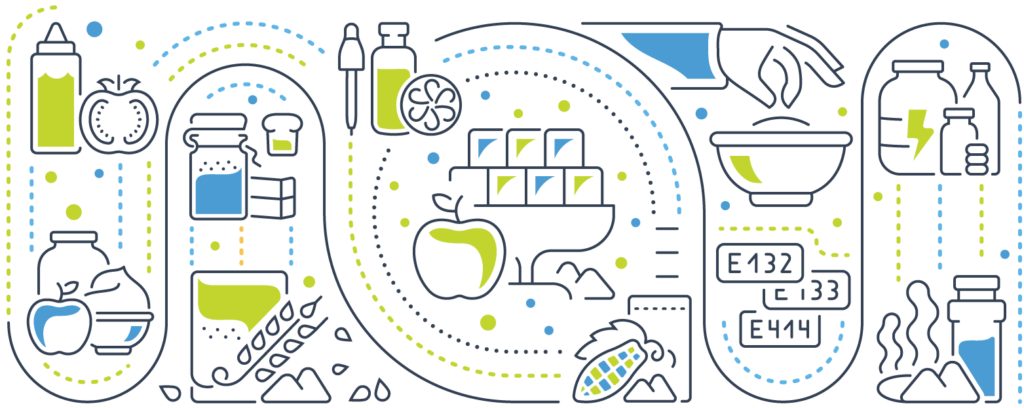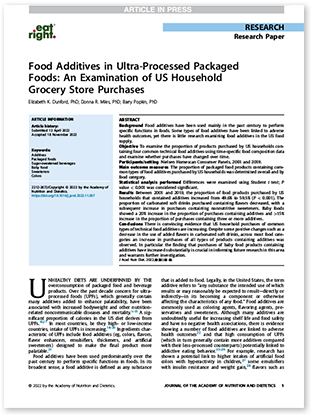A new study in the Journal of the Academy of Nutrition and Dietetics has found that 60% of foods purchased by Americans contain technical food additives such as coloring or flavoring agents, preservatives, or sweeteners. This represents a 10% increase since 2001. Manufacturers have also increased the average number of additives in purchased food and beverage products from 3.7 in 2001 to 4.5 in 2019. These findings indicate that prevalence of food additives is on the rise.
While food additives can extend shelf life and improve palatability, their health consequences are not fully understood, though mounting evidence points to high intake of ultra-processed foods — which often contain multiple additives — is connected to a multitude of health risks. Assessing food-additive exposure over time is a vital step in understanding its role in nutrition-related diseases, negative changes to the gut microbiome, and other adverse health outcomes associated with ultra-processed foods.

“Our research clearly shows that the proportion of ultra-processed foods with additives in Americans’ shopping carts increased significantly between 2001 and 2019. We observed this trend across all food and additive categories,” noted lead investigator Elizabeth K. Dunford, PhD, Food Policy Division, The George Institute for Global Health, University of New South Wales, Sydney, Australia, and Department of Nutrition, Gillings Global School of Public Health, The University of North Carolina at Chapel Hill, USA.
By 2019, more than half of the overall packaged food and beverage products bought by U.S. households contained three or more additives. Furthermore, and perhaps most concerning, a 22% higher percentage of baby food purchases were ultra-processed and contained additives. “These findings give us reason for concern, given the growing evidence linking high consumption of processed foods with adverse health outcomes,” noted Dr. Dunford, adding that the investigators observed one positive trend, a decrease in the use of added flavors in carbonated soft drinks.

By 2019, more than half of the overall packaged food and beverage products bought by US households contained three or more additives.
U.S. consumers purchase more than 400,000 different packaged food and beverage products each year at grocery stores, with new products constantly being added to shelves. Increased ultra-processed foods means that Americans are consuming more sugar, sodium, and saturated fats.

“With manufacturers producing foods and beverages with an increasingly higher number of additives, it is more important than ever to understand what is in the foods that Americans are buying and eating,” commented the study’s senior investigator, Barry Popkin, PhD, W.R. Kenan, Jr. Distinguished Professor, Department of Nutrition, Gillings Global School of Public Health, and the Carolina Population Center, The University of North Carolina at Chapel Hill, USA.
“U.S. consumers are demanding a much higher level of transparency from brands and retailers than in previous years. We hope the findings from this study will be used to inform policymakers on where Americans – especially babies – are being exposed to additives, and how the packaged food supply is changing,” Dr. Popkin said.
This is the first study to examine what U.S. consumers are purchasing – rather than relying on reported food and beverage intake – to evaluate exposure to food additives in ultra-processed foods, which is essential for assessing their role in the associated adverse health risks. The investigators used Nielsen Homescan Consumer Panel data from 2001 and 2019 to examine the proportion of products purchased by U.S. households containing four common technical food additives (colors, flavors, preservatives, and nonnutritive sweeteners) and to ascertain whether purchases have changed over time through the products’ scanned Nutrition Facts Panels. Previous research had been hampered by the lack of publicly available ingredient databases identifying and quantifying top additives in U.S. foods.
“The findings from this study could be used to inform policymakers on where American consumers are getting an increasing number of additives and how the packaged food supply is changing. The results can also set the foundation for future work in this area and provide direction for future researchers,” added Dr. Dunford. “At a minimum, I hope this work leads to further investigation into the types and amounts of ingredients being used in the manufacturing of baby food products.”
An accompanying editorial by Mona S. Calvo, PhD, and Jaime Uribarri, MD, of The Icahn School of Medicine at Mount Sinai, NY, New York, USA, cites the study’s contributions, “By providing data on exposure to food additives in ultra-processed foods found in grocery-purchased foods over time, Dr. Dunford’s team is leading the way with much-needed research. Their novel method enabled them to document food additive-exposure changes over time and by food and additive category,” said Dr. Calvo.
Dr. Unbarri added, “Most importantly, the authors’ unique approach enabled exposure estimates in the understudied, vulnerable populations of infants and children.”
Please refer to the detailed media release from the Journal of the Academy of Nutrition and Dietetics for more information about this study and additional resources.
Funding for this study came primarily from Arnold Ventures, with additional support from the National Institutes of Health.
Read the full article in the Journal of the Academy of Nutrition and Dietetics (full text available free for 30 days).
RESOURCES
Learn more about ultra-processed foods, their health risks, and policy approaches to curb consumption.

